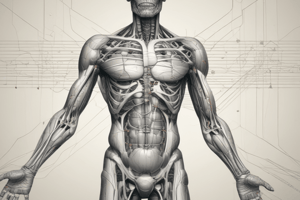Podcast
Questions and Answers
Which type of tissue is primarily responsible for communication within the body?
Which type of tissue is primarily responsible for communication within the body?
- Muscle tissue
- Epithelial tissue
- Connective tissue
- Neural tissue (correct)
What feature defines the anatomical position of the human body?
What feature defines the anatomical position of the human body?
- Upright with feet shoulder-width apart and palms facing forward (correct)
- Erect posture with arms at the sides
- Lying flat with face down
- Upright with feet together and palms facing back
In terms of anatomical terminology, which statement accurately describes the relationship of the nose to the eyes?
In terms of anatomical terminology, which statement accurately describes the relationship of the nose to the eyes?
- The nose is medial to the eyes (correct)
- The nose is superior to the eyes
- The nose is posterior to the eyes
- The nose is lateral to the eyes
Which of the following movements would be classified as abduction?
Which of the following movements would be classified as abduction?
Which plane divides the body into anterior and posterior sections?
Which plane divides the body into anterior and posterior sections?
Which term describes the movement that increases the angle between two body parts?
Which term describes the movement that increases the angle between two body parts?
What structure is responsible for filtering, warming, and humidifying air in the upper respiratory system?
What structure is responsible for filtering, warming, and humidifying air in the upper respiratory system?
Which of the following movements involves a turning motion of the forearm?
Which of the following movements involves a turning motion of the forearm?
Which terms correctly describe the relationship of the elbow to the shoulder?
Which terms correctly describe the relationship of the elbow to the shoulder?
Which type of connective tissue is primarily responsible for transporting oxygen and nutrients throughout the body?
Which type of connective tissue is primarily responsible for transporting oxygen and nutrients throughout the body?
What is the primary function of the nasal cavity?
What is the primary function of the nasal cavity?
How does the trachea maintain its structure?
How does the trachea maintain its structure?
Which part of the respiratory system is responsible for connecting the nasal and oral cavities to the larynx?
Which part of the respiratory system is responsible for connecting the nasal and oral cavities to the larynx?
What distinguishes the right main bronchus from the left main bronchus?
What distinguishes the right main bronchus from the left main bronchus?
What is the role of cilia in the epithelial tissue of the respiratory system?
What is the role of cilia in the epithelial tissue of the respiratory system?
Which structure of the lower respiratory system branches into secondary and tertiary bronchi?
Which structure of the lower respiratory system branches into secondary and tertiary bronchi?
What anatomical feature of the bronchioles enhances their elasticity?
What anatomical feature of the bronchioles enhances their elasticity?
What part of the respiratory system helps in shaping voice sounds?
What part of the respiratory system helps in shaping voice sounds?
Where does the trachea extend to and from?
Where does the trachea extend to and from?
What is the function of the nasal conchae in the respiratory system?
What is the function of the nasal conchae in the respiratory system?
Flashcards
Epithelial tissue
Epithelial tissue
A type of tissue that forms boundaries in the body, such as the skin and lining of organs. It's characterized by its layered structure and the shape of its cells.
Connective tissue
Connective tissue
A type of tissue that provides support, protection, and binding in the body. It's made up of cells embedded in an extracellular matrix of gels and fibers. Examples include bone, blood, and fat.
Neural tissue
Neural tissue
A type of tissue that is responsible for communication in the body. It's made up of neurons and supporting cells, transmitting signals through the nervous system.
Muscle tissue
Muscle tissue
Signup and view all the flashcards
Axial skeleton
Axial skeleton
Signup and view all the flashcards
Anatomical Position
Anatomical Position
Signup and view all the flashcards
Plane
Plane
Signup and view all the flashcards
Flexion
Flexion
Signup and view all the flashcards
Extension
Extension
Signup and view all the flashcards
Nasal Cavity
Nasal Cavity
Signup and view all the flashcards
Upper Respiratory System
Upper Respiratory System
Signup and view all the flashcards
Nasal Conchae
Nasal Conchae
Signup and view all the flashcards
Pharynx (Throat)
Pharynx (Throat)
Signup and view all the flashcards
Larynx
Larynx
Signup and view all the flashcards
Trachea (Windpipe)
Trachea (Windpipe)
Signup and view all the flashcards
Bronchi
Bronchi
Signup and view all the flashcards
Bronchioles
Bronchioles
Signup and view all the flashcards
Alveoli
Alveoli
Signup and view all the flashcards
Alveolar Wall
Alveolar Wall
Signup and view all the flashcards
Study Notes
Anatomy and Physiology Terms
- Tissues are groups of cells with similar structures and functions.
- Epithelial tissue forms boundaries and covers the body. It's categorized by the number of cell layers and cell shapes.
- Connective tissue supports, protects, and binds. It's made of fibers and gels. Examples include bone and blood.
- Neural tissue facilitates communication. Neurons and supporting cells transmit signals.
- Muscle tissue controls movement, including smooth muscle lining organs.
Axial Skeleton
- The axial skeleton includes bones like the clavicle, ribs, sternum, and vertebral column sections (cervical, thoracic, lumbar, sacral, coccygeal).
Anatomical Position
- Anatomical position: Upright, facing forward, feet shoulder-width apart, palms forward.
- Medial/Lateral refers to relative positions, e.g., nose is medial to the eyes.
- Sagittal plane is a vertical cut dividing body in half.
Planes of the Body
- Planes of the body are imaginary or real cuts through the body (based in anatomical position) including medial, lateral, sagittal, coronal, and transverse.
Respiratory System (Upper)
- The nasal cavity warms, humidifies, and filters inhaled air with cilia and mucosa.
- Nasal conchae in the cavity increase the turbulence for filtering.
- The oral cavity is an alternate route for airflow during heavy breathing.
- The pharynx connects the nasal and oral cavities to the larynx, and includes the nasopharynx, oropharynx, and laryngopharynx.
- The pharynx plays a role in voice resonance.
Respiratory System (Lower)
- The trachea, often called the windpipe, is supported by C-shaped cartilage rings.
- The trachea branches into two bronchi.
- The bronchi branch into smaller bronchioles.
- Bronchioles end in alveoli for gas exchange.
- Alveoli are tiny balloon-like structures where gas exchange happens.
Skeletal Framework of Respiration
- Vertebral column: Composed of vertebrae (cervical, thoracic, lumbar, sacral, coccygeal) and provides support.
- Ribcage: Made of ribs, sternum, and cartilage. Protects organs. Provides space and structure for respiration, as they expand during breathing.
- Shoulder (pectoral) girdle: Important connection point for muscles involved in inhaling.
- Pelvic girdle: Supports abdominal and lower back muscles involved in respiration.
Lungs
- The right lung is divided into three lobes; left into two.
- Lobes are separated by fissures (grooves).
- Function of lungs is in gaseous exchange and maintaining lung function.
Passive and Active Forces of Respiration
- Passive forces (in relaxed breathing): recoil of tissues, and gravity.
- Active forces (in forceful breathing): involve muscle contractions like the diaphragm and intercostal muscles, adjusting lung volume/pressure.
Neural Control of Tidal Breathing
- Brainstem, specifically the medulla, controls automatic, basic breathing patterns.
Posture and Body Position
- Posture and position affect respiratory efficiency. Different positions demand varying muscular support.
- Upright position: diaphragm and rib cage expand easily.
- Lying down: Expands rib cage with more work.
Aging and Respiration
- Lung capacity and function can decrease with age: alveoli, diaphragm strength.
- Aging also affects nerve sensitivity and the ribcage structure which affects respiration and consequently speech.
Studying That Suits You
Use AI to generate personalized quizzes and flashcards to suit your learning preferences.





